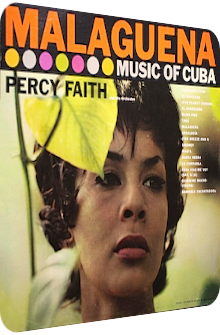
Percy Faith
Malaguena
1958
Taking his long career of many decades into account, conductor Percy Faith (1908–1976) is the chameleon of the Easy Listening genre, able to exotify orchestral standards as well as brassier compositions. During the 50's and early 60's, Faith basically relies on a huge amount of strings and a female choir, both ingredients not uncommon or overly exotic per se, but successful components of a balmy veil that silkens the harder edges of vivid piano arrangements or big band settings. In late 1958, shortly before Fidel Castro's control of Cuba, there was a slowly establishing market for Cuban rhythms in the veins of Spanish band leader Xavier Cugat, and so Columbia Records approached the multitalented composer Mr. Faith to transform and ennoble both the Cuban and general Latin material with lush strings and exotic percussion, but otherwise retain the hot-blooded or lamenting visions of the composers. Only the huge female choir is (almost) missing.
The result is called Malagueña: Music Of Cuba. From the liner notes: "The excitement and color contained in this collection is fulfillment of the promise of the title and artist. For Cuban music is enormously invigorating, and Percy Faith has long been famous for his arranging and conducting of Cuban And Latin-American melodies." Interestingly enough, the orchestra strings are only whirring in the background, literally filling the gaps of the staccato brass flourishes and Flamenco guitars, making Malagueña less of a Hollywood-focused work than a true-spirited Latin take. The album is still transfigurative. It poeticizes the mysteriously dubious isle of the 50's quite a bit, but offers an interesting glimpse into the supposedly unique soundscape of Cuba. The variety is also top-notch, many different tempos, subgenres and moods are on board. A large amount of 14 tracks made it onto the album, and even though the Exotica craze of 1958 does only partially permeate the intrinsic arrangements, Malagueña turns out to be a good hybrid between a dry, intimate Latin core and North American orchestra-based filter techniques that elevate this morphogenetic code base into something new that is farther away from the origin, but whose superimposition offers an easier access for the targeted group of contemporary listeners in the United States.
Ernesto Lecuona's titular Malagueña opens the album, and it is on the one hand the ultimate Latin tunes with a strong pathos and devotion, and on the other hand a splendid artifact waiting for distinct changes. Nothing beats Andre Kostelanetz's pompous take on Lure Of The Tropics (1954), but Percy Faith comes pretty close as he diminishes the grandeur: the main melody turns out to be surprisingly dreamy thanks to a silkened blur of brass instruments which then expectedly accelerate both in tempo and voluminousness. Clinging tambourins, interspersed maracas and a gorgeous interplay between dragonfly violins and paradisiac alto flute spirals unfolds. There is even room for a Flamenco guitar solo, with the only other instruments being tranquilizing but low-level violins which float as backdrop devices. Malagueña inherits the fulminant pompousness, but sounds milder and brighter. It is hard to describe for me, but a feeling that is supported by the majority of the forthcoming compositions.
Gonzalo Roig's Quiéreme Mucho follows and is a much better marker of Percy Faith's style. Enchanting flutes, bittersweet string washes, a golden acoustic guitar and sizzling maracas make this a lush but strongly doleful tune which only provides a syrupy euphony in the middle section. Moisés Simóns' El Manisero (The Peanut Vendor) is next and is the third tune in a row that completely changes the mood. Uplifting sun-soaked brass infusions are towering above a superb conga beat and distant strings. The tempo is rapid, the mood jocular and the scope curiously large and yet intimate. The different brass horn melodies present a show tune-like euphony that make this rendition a great take.
Up next is a rendition of Danza Negra, another one of many tunes by Ernesto Lecuona. Aqueous claves and a conga aorta build the jungular thicket for an unfortunately way too cheesy polyphony of good-natured flutes and strings. The violins float freely and jovially but are too saccharine for my taste. Lecuona's next song is better orchestrated, the well-known Exotica gold standard Andalucía, probably better known as The Breeze And I, surprises with liquid harp cascades, a rhythm in 3/4 time and silky flute waves in-between the lofty strings and bedazzling frizzles of the maracas and glockenspiels. Staccato brass blasts, pizzicato strings and a very distant, almost imperceptible female choir round off the good-natured mood. This might be Easy Listening, but it is very vivid and dynamic.
Up next comes another real treat, Richard Egües' Merengue El Bodeguero. It seems to come from another album, composer or even time, since its style is so different. A maximum of blitheness is unchained in the forms of eupeptic brass blasts, Portuguese accordions and croaking guiros which altogether play the downright catchiest melody on side A. If you want an even funnier take on the already blasting happiness, consider Frenchman Karl Zéro's vocal mockup on his millennial album Songs For Cabriolets for an even larger boost of hilarity. Side A, however, closes with Lecuona's Damisela Encantadora and ends things with a fulminantly melodramatic Waltz of yearning strings which suddenly morph into a glockenspiel-accompanied Space-Age polyphony, losing the burdening heaviness that was heretofore adamant.
Side B continues the variety with another duo of Ernesto Lecuona-invented compositions. While Siboney takes the crown due to its over-the-top melodrama which is realized with door-blasting horn flourishes, quavering threnodic strings and a frantic double bass backing, La Cumparasa brings back that plastic jungle feeling thanks to its hollow bongos, sunset guitars and doleful flutes which then float into a catchy euphoria of sugar-sweet tone sequences. It is Antonio Castro's and Santana Raminez's Tumbando Cana which changes the soundscape to sizzling-hot staggering brass stabs, tribal bongo rhythms in Balkan style and gorgeous faux-Polynesian flutes. Affection and devotion are all over the horizon and make this critter one of the genuine surprises of the album.
Easy Listening? Not at all! But Moisés Simón's Marta sure as hell is. Lachrymose gypsy strings in tandem with their mellifluous brethren, a sugar-coated lead trumpet and glockenspiel glints make this a seriously kitschy but somehow great ballad with not even a trace of Latinism in sight. Whereas Eliseo Grenet's Mama Inez is a Pérez Prado-esque sunside Mambo full of catchy euphonious brass riffs and a jocularly whistling flute, the dichotomous Para Vogo Me Voy (Say Sí Sí) uses the same cinematic amount of brass players and puts their blasting impetus into a whirling mawkish maelstrom of clicking claves, melancholic strings and warm-hearted chorus sections as if the preceding melodrama did not happen at all. The final Tabu by Ernesto Lecuona's niece Margarita is the cream of the exotic crop on this album, for Percy Faith decides for a James Bond-esque brass stab (roughly five years before the famous theme was even composed!), frantic drums and a rhythmic shift to languorous realms. An acoustic guitar backs the well-known lamento of the strings and flute sections, but is much lessened by the orange-tinged vibe of the brass players, making Tabu more of an embracing than a contemplative version. A very huge and successful interpretation which closes the vivid album in a magnificent way.
Malagueña: Music Of Cuba is one of the best and most successful Latin albums of the 50's. It is not boldly Exotica-related, but whenever a placenta of exotic percussion is placed in a tune, it reminds of vivid material in the veins of Les Baxter. Even though Percy Faith or Columbia Records do not boast about the drums in the liner notes, they are much more important than one might expect. Despite the short glimpses of true-fashioned Easy Listening sugar, the arrangements succeed with their purposely oversaturated brass instruments, the soothing alto flutes and lush strings. I am no fan of the lamenting Latin themes, but thankfully the vivacious hooks and tone sequences outweigh the murkier ones. Strong favorites are the cheeky El Bodeguero, the vivid take on Tabu and the dreamlike Marta. Close contenders comprise of the stomping trait of Tumbando Cana and the gleeful atmosphere in Andalucía (The Breeze And I), but heck, you better not care about my opinion and check this album out yourself.
Percy Faith's tactics in terms of altering the Latin core of each featured take fully accomplish the intended effect. It is one of the albums both Retro Latin and Exotica fans can relate to with ease. Followers of Xavier Cugat, Cal Tjader's Latin output and the great Pérez Prado should definitely check this one out. The everchanging arrangements, the mediation between intimacy and a largely orchestrated pompousness, the follow-up of brighter tones in major after a melancholic gloominess encompass all the tasteful stereotypes of the Latin genre. And remember that the alternative goal of this album – besides cashing in – is to introduce a North American audience to Latin cuts and that strangely shaky neighbor called Cuba. Regardless of a success in this regard, Malagueña is one of my essential Latin albums for starters and even those Exotica listeners who are normally wary of the genre. It is available on iTunes and Amazon in a digital version which was remastered in 2009. Even the LP is easy to fetch for a fair price. Strongly recommended as a whole, but if you are fond of a certain style and mood or only want to listen to the rather exotic pieces, pre-listen and cherry-pick.
Exotica Review 162: Percy Faith – Malagueña (1958). Originally published on Dec. 29, 2012 at AmbientExotica.com.
